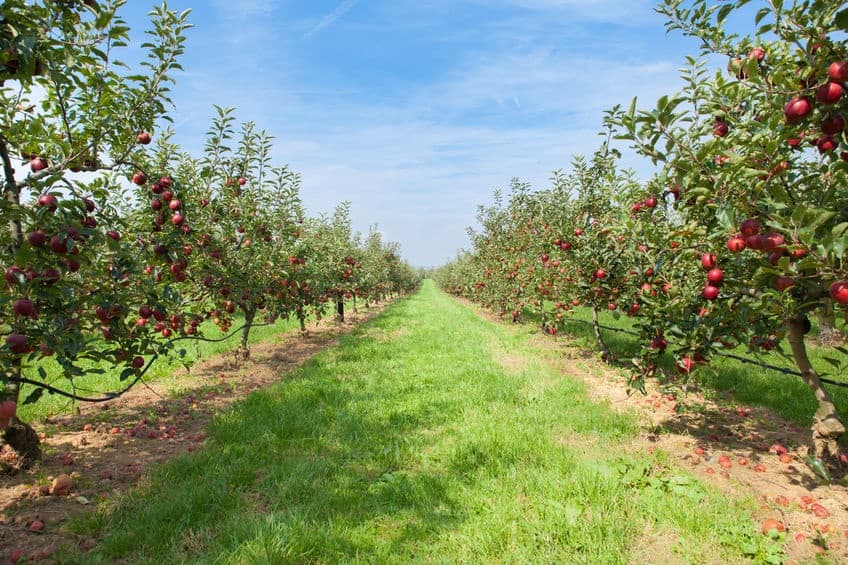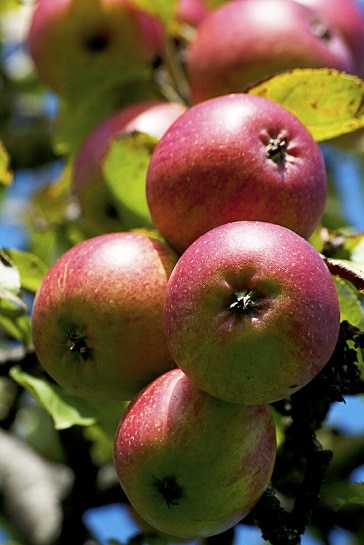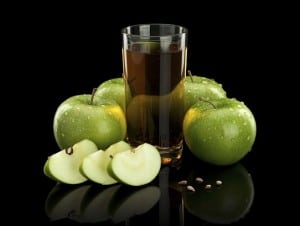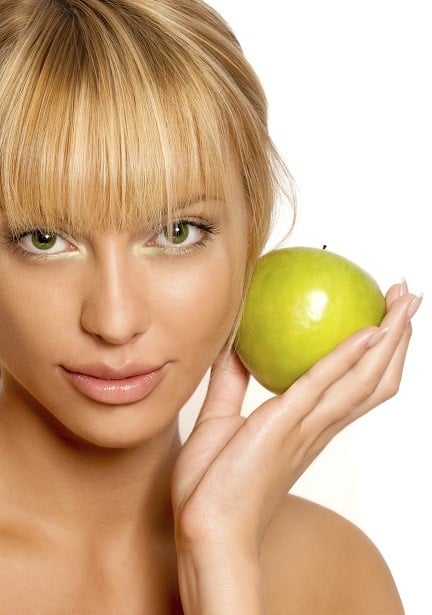 Like many people, the mixed messages about pesticides might be driving you crazy.
Like many people, the mixed messages about pesticides might be driving you crazy.
You might have heard that certain foods, namely strawberries, tomatoes and apples, are particularly dense in invisible agrochemicals, hiding on the skins and presenting a invisible and silent threat which you can only dodge by going organic. You might have read about farm workers taking their industrial employers to court over sudden infertility.
However, you might also have read newspaper articles declaring organic foods to have no advantage, paid for by Food Inc. If you’ve been sucked into natural health trends before like kale only diets, or simply enjoy ranting at the TV screen in the evenings, then this supposed deception might have seriously annoyed you.
So what’s the truth about apples? They’re a top acne-clearing fruit due to their plentiful phenolic antioxidants, but is organic a must?
Apple pesticide mania
There’s no point in beating about the bush here. Apples, as a farmable crop with orchards everywhere devoted to them, rank right at the top of the pesticide pile.
For the past 10 years, apples have never left the top 5 most pesticide contaminated foods. This is shown by the Environmental Working Group’s lists they combine every year – the dirty dozen and the clean fifteen.
Now, it’s undeniably odd that the exact numbers happen to correspond to a tidy rhyme – what about number 13 and 16? Nevertheless, the last 5 years have seen…
2016: Strawberries (1st), apples, nectarines, peaches, celery (5th).
2017: Strawberries, spinach, nectarines, apples, peaches.
2018: Strawberries, spinach, necatarines, apples, grapes.
2019: Strawberries, spinach, kale , nectarines, apples.
2020: Strawberries, spinach, kale, nectarines, apples.
From 2011-2015, apples held the top spot for 5 years running. Apples have either become slightly less contaminated, or strawberries and spinach have formed a tag team and caught up with them.
However, it’s a drop in the ocean compared to the insidious damage they’re capable of. Whatsonmyfood.com is the most easily usable pesticide website out there (highly recommended for instantly checking your favourite fruit). According to them, 82.8% of apples contain diphenylamine, 81% contain the fungicide thiabendazole, 75.2% contain pyrimethanil (a fungicide), and 41.2% contain chlorantraniliprole (an insecticide).
Apples contain an average of 4.4 pesticide residues. In one test, 98% contained at least one pesticide.
Imidacloprid – the chief offender
 Consider imidacloprid, part of the controversial organophosphate insecticide family.
Consider imidacloprid, part of the controversial organophosphate insecticide family.
In 2018, the EU voted to ban 3 organophosphate pesticides: imidacloprid, thimethoxam and clothianidin. They were outlawed effective April 27th 2018, for personal garden usage (except greenhouses) and all agriculture.
Critics argue that they left open 67 loopholes, including keeping golf courses trim and proper, probably for when a foreign president is visiting. But at least they did something; the US is the heartland of imidacloprid. It’s sprayed in orchards to kill aphids, insects which love apple fruits even more than we do. Farmers can blast the fruits directly, but it’s more effective to spray the apple orchard’s soil. There, the roots will absorb the imidacloprid and distribute it, making the tree’s fruits and leaves inherently insect-proof.
As you sit in the city park on a sunny day having a picnic, this insecticide is still inside the apple.
Imidacloprid is most notorious for decreasing honeybee populations, but it also dabbles in chronic inflammation and reproductive problems. Imidacloprid is detoxified via the glutathione pathway, meaning that every molecule will deplete your levels slightly. It’s not a chemical you want patrolling your bloodstream.
In 2017, some Kuwaiti scientists hauled a ton of fruit back from local markets, and 10 apples were tested. 90% contained pesticide residue, beating all other crops, including grapes (86%), watermelon (83%) and strawberries (70%).
But it doesn’t end there: apples also received the prize of longest distance. The longest distance past the maximum residue barrier, as 80% of apples exceeded safety limits, compared to 50% of grapes, 50% of watermelons, and 40% of strawberries.
Which insecticide was particularly prominent? Imidacloprid, found in 60% of apples. They then ate the apples (I’m assuming anyway).
Apples – an international pesticide villain
Next, we have two British companies which watch conventional produce like a hawk: Pesticide Action Network (PAN) UK and the Soil Association.
Some quick strategical advice: if you’re visiting UK shores and buying organic foods, then always scan for the Soil Association symbol, as it’s the British equivalent of the USDA organic stamp.
Overall, one third of non-organic foods on supermarket shelves contained pesticide cocktails (study). So did a third of bread, but apples blasted through this barrier at light speed, with 64%. Pears were worse, achieving 87%.
Multiple pesticides is dodgy already, but worse, villains like permethrin and malathion can mutate into more than the sum of their parts when combined.
People think of glyphosate, but it’s the star ingredient in Monsanto’s Roundup, not the only one. Agrochemicals are combined for a reason; adjuvants, for example, enhance the penetration of insecticides through the outer wax and into the cellular wall of the plant.
Likewise, atrazine, alachlor, and trifluralin penetrate human skin extra effectively when mixed, and similar reactions happen when eating a juicy red apple. This rat study found that when joining forces, malathion and DEET (insecticides) each became more neurotoxic than normal. It’s a synergistic effect, and that’s partially why the EPA’s safety limits are so misleading.
When seeking approval, scientists usually only test chemicals in isolation. Furthermore, those studies are usually conducted by the pesticide manufacturers anyway! Independent scientists struggle to find a place.
Plus, it’s safety that should be proven, not danger. Farming unions always argue that there’s “no compelling evidence” against individual pesticides, but innocent until proven guilty doesn’t apply to an artificial chemical!
Caution is vital, especially after the sorry tales you will read below…
Apple pesticides – 30 years ago
 For 30 years, the chemical alar was a staple on apple orchards everywhere. It was almost the single most popular apple insecticide, and perfect for irresistible, bright neon grocery store stands, enhancing the apples’ red colour vividly.
For 30 years, the chemical alar was a staple on apple orchards everywhere. It was almost the single most popular apple insecticide, and perfect for irresistible, bright neon grocery store stands, enhancing the apples’ red colour vividly.
These days, you’ll only find alar on obscure ornamental plants. What went wrong?
It all started with behind the scenes experiments in the 1980s, causing the Natural Resources Defense Council to declare in 1989 that because of loose regulations on numerous chemicals, including alar (daminozide), the average child’s lifetime cancer risk was 240 times higher than what the EPA deemed acceptable.
By February 1989, this had caught the eye of CBS’ 60 minutes program. Their segment opened with red, shiny apple with a skull and crossbones superimposed on it, instantly swivelling viewer’s heads.
On national TV, the US’s top pesticide regulator told CBS reporter Ed Bradley that alar would have never been approved under the government’s current pesticide criteria. Why? Because it was extremely carcinogenic (cancer-causing). The problem was, he claimed, that alar was first approved in 1962, exempting it from future changes. The government could do nothing, he shrugged.
The public, however, disagreed. The alar panic of 1989 was amazing to behold, quite possibly the greatest moment of direct consumer action ever.
Horrified mothers poured their apple juice down the sink the second they turned the TV off. School cafeterias panicked and stopped serving apples to their children. Even Meryl Streep testified to congress. The shockwaves filtered through to big supermarket chains, who declared that they wouldn’t accept apple crops treated with alar.
Two years later, alar was banned by the federal government. Uniroyal Chemical Co. had taken alar off the market in 1990 anyway, being lumped in with the forces of evil and all.
The “alar scare” became a byword for media hype, attention-grabbing headlines and scare stories that spiral out of control. Farmers argued that there was never any evidence, calling it a big fuss over nothing, but the cancer studies were very real. They were slightly exaggerated, no doubt about it – but the rat results indicated 5 extra cancer cases per 1 million, well above the 1 per million level needed for action.
Over the next decade, the apple industry tried desperately to fight back. They claimed that to suffer harm from alar, a child would have to eat 800 apples a day! Even the EPA rubbished this story.
Meanwhile, Washington State apple growers sued CBS for libel, claiming that their 60 minutes program wreaked havoc on their livelihoods. But this court case failed at every turn. A lower appeals court said that “the growers have failed to raise a genuine issue of material fact as to the falsity of the broadcast“.
Auvil v. CBS “60 Minutes” even reached the Supreme Court, who dismissed the $250 million lawsuit without comment on April 29th 1996. Apple growers were so resoundingly defeated that it led to “veggie libel laws”, designed to suppress negative coverage of agricultural practices.
Interestingly, the apple collective claimed that they stood to lose millions, but by November 1990, the withdrawal of alar had barely dented the industry’s value.
Today, you’ll see chemical giants on the news saying the exact same thing when modern pesticides are debated, including with apples.
Apple pesticides – 10 years ago
Azinphos-methyl was introduced in 1959, and also became a staple of tobacco trees. AZM was a farmer’s secret sauce against the codling moth, the insect behind “maggoty apples”.
Their caterpillars bore into the apple’s soft flesh, which a farmer realises from the entrance “eye” on the skin. After cutting the apple open, you can see the caterpillar’s tunnel. Affected apples tend to ripen early and fall off the tree, but it’s too late for customer anyway – caterpillar was never on the menu. The only thing worse than finding a worm in your apple is finding half a worm.
Farmers have one natural method: they extract the pheromones of female caterpillars (somehow), and lure the eager male caterpillars into a trap. But azinphos-methyl is better; for years, it was the single most applied agrochemical to apples in the US.
Sadly though, the chemical is a jack of all dark trades. It depletes glutathione, increases oxidative stress, causes neurotoxicity, and weakens the p450 enzymes of the detoxification system. AZM can be absorbed directly through the epidermis, the outer layer of skin cells.
Most notoriously, clouds of AZM were drifting from apple orchards into children’s playgrounds, which was horrific given its known neurotoxicity.
In 2001, the EPA slammed down the ban hammer for the tobacco industry, but apple farmers could still spray their trees to keep hungry moths away. Only after lawsuits from sick farm workers and environmental groups did the FDA finally outlaw AZM for good. By September 30, 2008, it was banned for Brussels sprouts farming. By 30 November 2009, it was banned for almonds, walnuts and pistachios. Apples, grapes and cherries were scheduled for 2012, but at the last minute, apple farmers were granted an extra year to use existing stocks due to “unusual weather conditions”.
In 1991, one toxic apple chemical was banned. People rejoiced everywhere – apples were back on the menu. But by 2006, another one was a national villain. The cycle continued.
This is why you can’t trust regulators who insist that chemicals are safe. As the saying goes – the agriculture industry is always “safe”, and when they ban a toxic chemical, it gets “safer”.
Are there still invisible pesticides on the skins of our apples? Which chemical is next to fall? There’s a great candidate…
Apple pesticides – present day
 The story might have another chapter within 10 years, or even 5. This is a classic battle across the Atlantic sea: Europe restricts diphenylamine, while America permits it.
The story might have another chapter within 10 years, or even 5. This is a classic battle across the Atlantic sea: Europe restricts diphenylamine, while America permits it.
First registered in 1960, dipehnylamine isn’t technically a pesticide at all, although it’s regulated like one. It’s a chemical antioxidant which keeps harvested apples free from brown mould patches during the long, cold months of storage, which have the alliterating name of “storage scald”.
The most recent US data (2016) found that 80% of apples contain DPA, as do 36% of apple sauces.
It started in 2012, when European scientists declared that the DPA industry hadn’t provided enough evidence of its safety. In June 2012, the EU banned DPA outright in apple and pear harvesting. By March 2013, even imported apples were allowed only 0.1 parts per million. This was bad news for New York apples farmers as somehow, British and Irish supermarkets particularly loved their small and medium apples; it was a profitable niche for them.
Meanwhile, US apples can contain 10 parts per million. American growers can inundate their orchards with DPA with no restrictions. In fact, the Environmental Working Group says that when approached about the EU’s import restrictions in 2013, EPA officials had no idea what they were talking about!
The World Health Organisation announced that DPA was “unlikely to present a public health concern” in 2007. The EPA last reviewed it in 1998, finding no unacceptable risk to human beings or the environment.
Could diphenylamine be the next alar or azinphos methyl? EU scientists argue that the lack of toxic evidence isn’t because it isn’t toxic, but because of lazy investigating.
Because diphenylamine is sprayed after harvesting, it appears in unusually high concentrations. Its signature danger is fairly unique. Rather than a run of the mill inflammation spike (which you should still never underestimate), DPA may generate toxic nitrosamines when the apples sit in storage.
These cancerous toxins are why processed meat is so feared, as the nitrites in sausages react with stomach acid to create them. Importantly, nitrosamines live up to their name: they form when nitrogen react with amines, exactly like our friend diphenylamine. European scientists are terrified, and their experiments were slightly inconclusive, detecting 3 unknown chemicals in DPA-treated apples. They tentatively put nitrosamines under suspicion, but personally, this is enough – 3 unknown chemicals materialising from thin air?
People have been campaigning against nitrosamines in ham and sausages since the 1970s; it turns out that processed, not unprocessed red meat is the real cancer risk. They’re particularly skillful at causing stomach and esophageal cancers, and their acne powers include free radical overload. If DPA does generate nitrosamines, then that’s nothing to sniff at.
I fully expect diphenylamine to be the next warzone in the apple farming world. Mark my words!
Bonus secret – use baking soda
How do you remove the pesticides clinging to apple skins? Easy – peel off the skins. Some herbicides, like the thiabendazole found on 88% of apples, can penetrate 4mm into the skin, 4 times deeper than other pesticides. Nevertheless, peeling can’t be beaten.
The problem then? The skin is also where most of the antioxidants are concentrated. The dash of red like a paintbrush on the green background, with no two apples looking the same, is a constellation of phenolic compounds like quercetin and ferulic acid.
Luckily, there’s a secret solution – baking soda. In a recent 2017 study, rinsing apples in baking soda for 12 and 15 minutes removed 80% of the thiabendazole and 95% of the phosmet respectively. An industrial apple bleach was significantly weaker. Previously, bleach was considered ideal; a mindless dunk in Clorox is the standard post harvest cleansing method. Swirling just a teaspoon of baking soda into a cup of water did the job.
That said, not every pesticide was removed, and thiabendazole clung on harder because of its superior penetration. It had burrowed further into the apple fruit, hiding from your naked eye before you eat it.
Furthermore, the apples weren’t taken directly from orchards, but drenched in pesticides in the laboratory. Consequently, it doesn’t mimic a real apple farm when the insecticides are sprayed into the soil and uptaken into the roots.
It’s a great secret for your memory banks, but baking soda won’t save commercial apples from acne villainhood.
The verdict
In the past, we’ve discussed coffee and chocolate, a fateful question for all acne sufferers. They’re two of the ultimate skin-friendly treats, the perfect replacements for donuts and cotton candy. Thankfully, coffee and cocoa beans are drenched with pesticides, but the roasting process shields them, shattering the molecular structure of most agrochemicals.
Apples, however, are left in the cold, with no such protection.
Washing and baking soda are your best hopes, but overall, I strongly recommend buying organic apples. The inflammation and free radicals will send the inner fuel of your acne bubbling slightly further upwards. A stubborn pimple will be slightly redder and angrier. That’s ignoring the risk of hormone disturbances, neuron death and maybe even cancer.
Stay away from conventional apples! If you see one flying through the sky towards your mouth, then duck.
There’s some good news though: organic apples are relatively cheap compared to organic foods. It’s the same with organic potatoes, organic strawberries, and organic bananas, all of which I recommend. There’s no comparison to organic blueberries or raspberries.
Thanks for reading!
